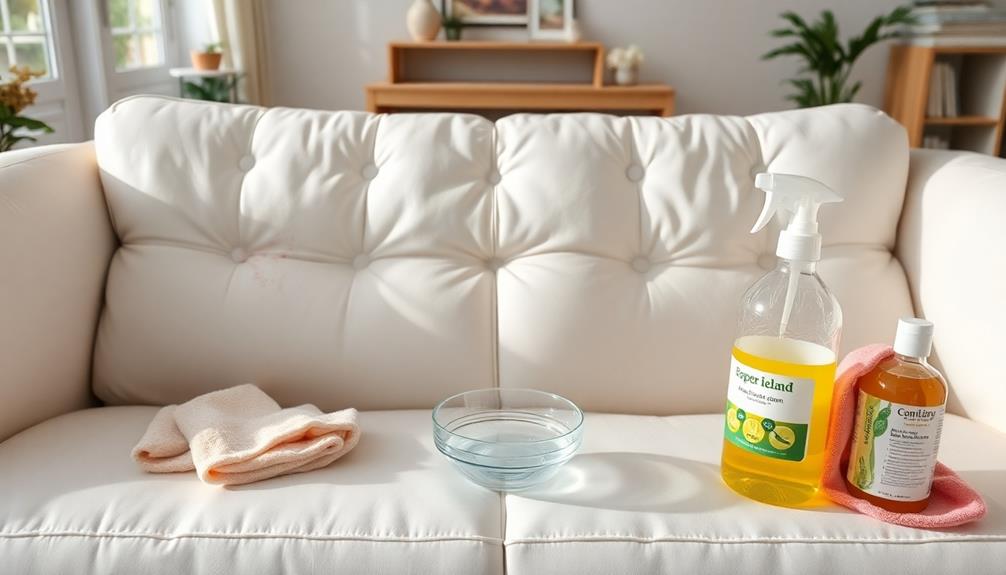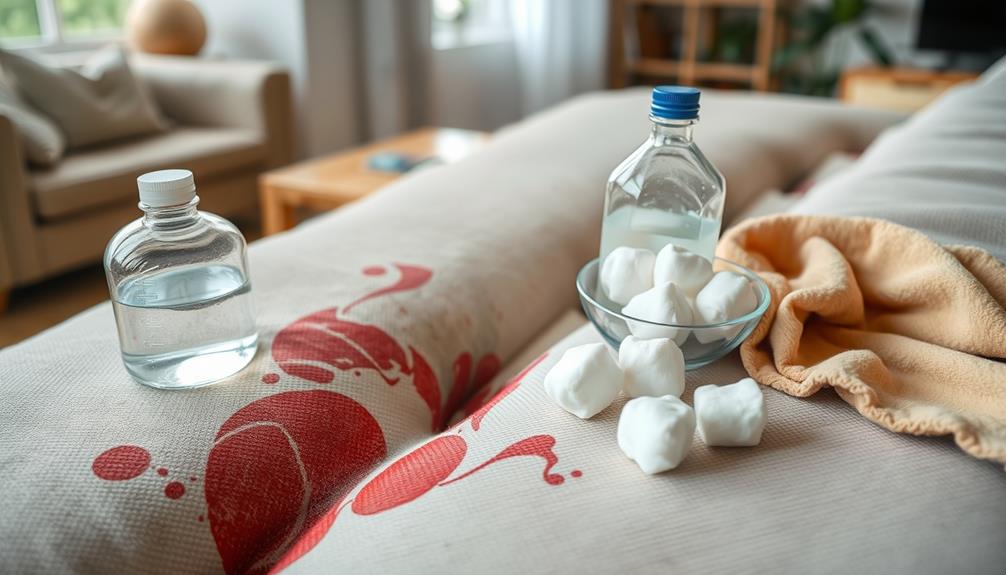You can effortlessly create a grunge-inspired sanctuary that combines edgy aesthetics with cozy vibes, impressing anyone who enters your space. Begin by choosing a color palette of grays and blacks, while adding pops of vibrant accents for a striking contrast. Integrate vintage furniture pieces, such as a distressed metal chair and a reclaimed wood coffee table. Layer oversized textiles and mix patterns to enhance the texture. Incorporate exposed bulbs and neon signs for a unique lighting scheme. Lastly, display your personality with vintage band posters and rustic decor elements. Continue reading to discover additional tips and tricks for crafting the ideal grunge ambiance!
Key Elements
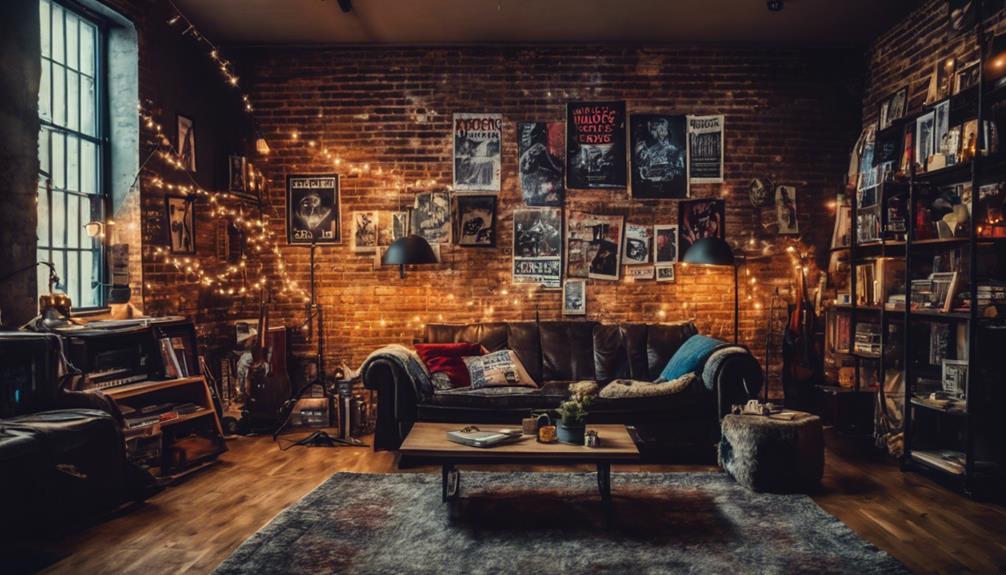
To create a true grunge room, you'll want to focus on your color scheme, materials, and textures.
Stick to a palette of grays and blacks, while mixing in different textiles like velvet and leather for depth.
These key elements will help you craft an inviting yet edgy space that reflects your personal style.
Color Scheme
The grunge color scheme thrives on a mix of muted tones like grays and blacks, which evoke the rebellious spirit of the 90s while allowing for vibrant accent colors to create striking contrasts.
Your grunge color palette should primarily feature deep greens and dark hues, capturing that melancholic vibe. To keep things interesting, don't hesitate to incorporate bold colors like red, green, or blue. These accents can pop against the darker background, making the space visually engaging.
If you're looking for a fresh twist, consider pastel grunge. This modern interpretation introduces lighter, neutral tones while still maintaining the edgy essence of traditional grunge.
You can also layer different shades and textures to enhance the cozy, lived-in atmosphere typical of grunge spaces.
Materials
Creating a grunge room involves selecting a mix of materials that reflect your unique style while capturing the raw, edgy essence of the aesthetic. Start by incorporating vintage and repurposed furniture; hunt for unique pieces at thrift stores or garage sales to enhance the eclectic vibe of your grunge room decor.
Metal accents are essential, so consider studded headboards, industrial-style furniture, and metal wall art to add that edgy touch.
Don't forget to weave in natural elements! Potted plants and hanging greenery can provide a revitalizing contrast to the darker tones typically found in grunge decor, making your space feel more inviting.
Layering different patterns and materials in textiles is key. Use geometric bedding and patterned throws to create visual interest and depth.
Lastly, choose fabrics like velvet, leather, and wool for your rugs, throw pillows, and blankets to invite comfort into your room. These materials not only enhance the aesthetic but also make your space feel cozy and lived-in.
Textures
Textural layering is essential in achieving the authentic grunge aesthetic, as it combines diverse materials to add depth and character to your space. Start by incorporating oversized textiles like chunky knit blankets and large area rugs. These elements enhance the cozy vibe typical of grunge decor, making your room feel inviting.
Next, mix different patterns—think plaids, stripes, and florals. This eclectic feel contributes to the overall charm of your grunge room, allowing you to express your unique style. Don't forget about vintage and repurposed furniture; these pieces introduce unique textures and histories that enrich your layered aesthetic.
Additionally, consider adding metal elements like studded accents or industrial-style furniture. These edgy touches contrast beautifully with the softer textures in the room, creating a dynamic visual appeal. By carefully selecting and layering various textures, you can create an environment that not only stands out but also tells a story.
Essential Fixtures and Furniture
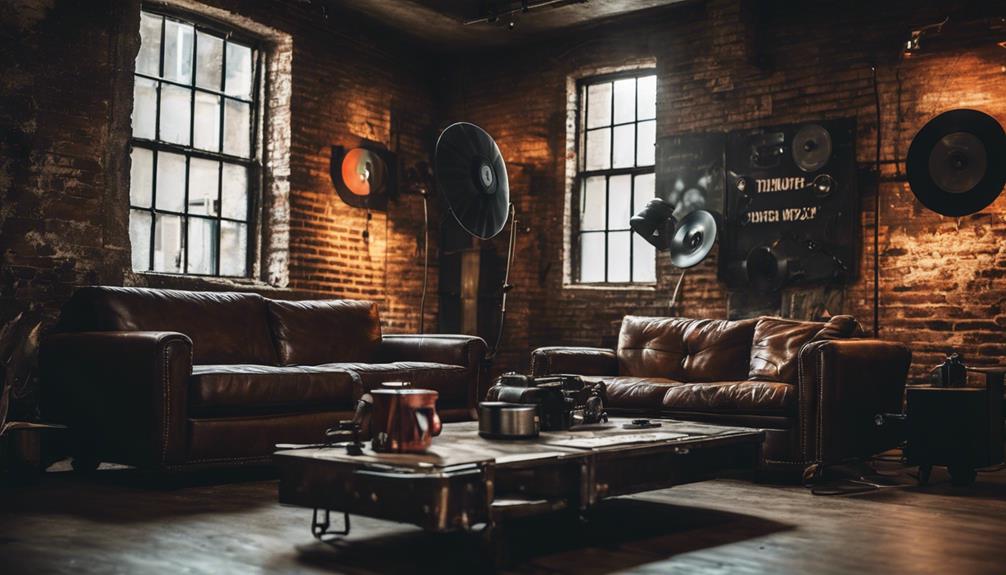
When you're curating your grunge room, think about incorporating essential fixtures that reflect the aesthetic.
A vintage industrial metal chair and a reclaimed wood coffee table can serve as both functional pieces and bold statements.
Don't forget a vintage record player stand to complete the vibe and showcase your music collection.
Vintage Industrial Metal Chair
Vintage industrial metal chairs add a rugged charm to your grunge room, blending durability with an edgy aesthetic. Characterized by their distressed finishes and exposed welds, these chairs become essential fixtures in your decor. Made from sturdy materials like steel or iron, they not only provide reliable seating but also contribute a unique style that enhances the overall vibe of your space.
You can easily incorporate vintage industrial metal chairs into your design scheme. Their versatility allows you to use them as both seating and decor pieces, creating an eclectic atmosphere that feels authentic and individualized. Pair these chairs with mismatched furniture to achieve that cozy yet cluttered look that defines grunge style.
Sourcing vintage industrial metal chairs from thrift stores or online marketplaces can be a budget-friendly way to add character and history to your room. Each piece carries its own story, making your space feel more personal. With their bold presence and rugged appeal, these chairs will impress your friends and invite conversation, solidifying your grunge room as a creative haven.
Reclaimed Wood Coffee Table
A reclaimed wood coffee table not only enhances the rustic charm of your grunge room but also highlights sustainability with its unique character and history. Its distinct imperfections tell a story, making it a conversation starter among friends. Choosing a table with a weathered finish or distressed look perfectly complements the grunge aesthetic, blending seamlessly with your vintage or thrifted furnishings.
The natural textures of reclaimed wood contrast beautifully with metallic or industrial elements in your home decor, adding visual interest and depth. Opting for a coffee table that doubles as storage—like one with a lower shelf or hidden compartments—helps maintain a cozy yet slightly cluttered atmosphere, typical of grunge style.
Additionally, selecting a coffee table with simple, clean lines offers versatility in styling. You can easily showcase eclectic decor items like books, plants, or art pieces, allowing your personality to shine through.
Vintage Record Player Stand
Transform your grunge room with a vintage record player stand that not only showcases your music collection but also enhances the retro vibe of your space. This essential fixture provides a functional base for your record player while elevating your room's aesthetic.
When choosing a vintage record player stand, look for materials like wood or metal, as they perfectly complement the eclectic and rugged feel of grunge style. A stand with shelving allows for easy storage and display of your vinyl records, making them accessible while adding visual appeal.
Opt for unique design elements, such as ornate legs or distressed finishes, to bring out the vintage charm and add a personalized touch to your room. If you're feeling creative, consider DIY options. Repurposing old furniture, like a side table or crate, can give you a custom record player stand that reflects your individual style.
Incorporating a vintage record player stand into your grunge room not only enhances your music experience but also serves as a striking focal point that's sure to impress all your friends!
Lighting Ideas
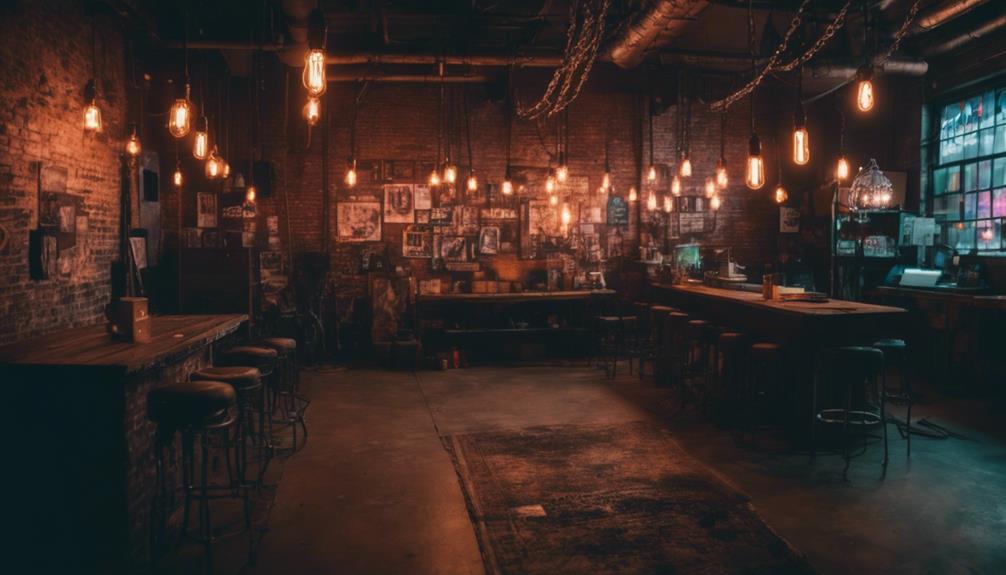
When it comes to lighting in your grunge room, think about using exposed bulb pendant lights to amplify that raw, edgy vibe.
String lights with clips can add a playful touch, while a neon sign can serve as a striking focal point.
Don't forget to install a dimmer switch; it'll let you set the perfect mood for any occasion.
Exposed Bulb Pendant Lights
Exposed bulb pendant lights effortlessly enhance the grunge aesthetic, adding a raw, industrial touch that complements the room's edgy vibe. These fixtures come in various designs, allowing you to choose between vintage-inspired and modern industrial styles that reflect your personal taste.
When placed strategically, exposed bulb pendant lights create dramatic shadows, highlighting key decor elements and enhancing the cozy yet rebellious atmosphere of your grunge room.
Opting for warm-toned bulbs in your exposed pendant lights can soften the harshness of darker walls. This creates a welcoming glow that contrasts beautifully with the room's darker elements.
Additionally, consider incorporating dimmable exposed bulb pendant lights to adjust the ambiance according to different moods and activities. Whether you're hosting an intimate gathering or a lively hangout, these lights can cater to your needs.
String Lights With Clips
String lights with clips add a playful yet stylish element to your grunge room, allowing you to showcase personal photos and artwork while enhancing the overall atmosphere. These versatile lights can be easily hung along walls or draped across furniture, creating a warm, inviting glow that beautifully contrasts with the darker color schemes typical of grunge decor.
The soft illumination provided by string lights with clips can elevate the moody ambiance of your space, making them perfect for dimly lit areas where you want to relax and unwind. Available in various styles—from whimsical fairy lights to more industrial-themed designs—these lights complement the eclectic and layered textures that define grunge aesthetics.
Incorporating string lights with clips encourages you to express your creativity, as you can frequently swap out the displayed items, ensuring your decor stays fresh and engaging. This dynamic feature not only personalizes your space but also invites your friends to enjoy and appreciate your unique style.
Neon Sign Accent Lighting
Neon sign accent lighting can instantly transform your grunge room by adding a vibrant focal point that contrasts beautifully with the darker tones of your decor. These neon lights serve not only as illuminating features but also as expressions of your personal style. Whether you choose a quirky phrase or an eye-catching image, the right neon sign can enhance the edgy atmosphere that defines grunge.
Positioning your neon lights strategically is key. Place them above your bed for a striking centerpiece or in a cozy corner surrounded by plants to create an inviting yet rebellious vibe. The playful contrast between the raw, vintage elements of grunge decor and the sleek, modern look of neon can elevate your space dramatically.
You'll find that battery-operated or plug-in neon signs offer flexibility, making it easy to experiment with different arrangements until you discover the perfect fit for your aesthetic. Don't hesitate to mix and match your neon lights with other lighting elements to craft a unique ambiance that truly speaks to your individuality.
With the right neon sign, you'll impress all your friends and create a room that's undeniably you.
Dimmer Switch for Mood Lighting
A dimmer switch lets you effortlessly adjust the lighting in your grunge room, creating the perfect mood for any occasion. By installing a dimmer, you gain the flexibility to shift between bright illumination during the day and soft, ambient light in the evening. This adaptability is vital for crafting that cozy, moody atmosphere that enhances your grunge aesthetic.
Pairing warm-toned LED bulbs with your dimmer switch not only evokes a vintage vibe but also guarantees energy efficiency. You can even combine the dimmer with fairy lights or colored LEDs, allowing you to tailor the mood lighting to suit different events or personal preferences.
The ability to control light intensity can dramatically transform your space, making it feel more inviting and personalized. This is significant for achieving the eclectic charm that defines grunge decor.
Whether you're hosting friends or enjoying a quiet night, effective mood lighting helps set the right tone. So, consider adding a dimmer switch to your lighting setup; it's a simple yet powerful upgrade that can elevate your grunge room into an impressive sanctuary of style and comfort.
Decorative Elements
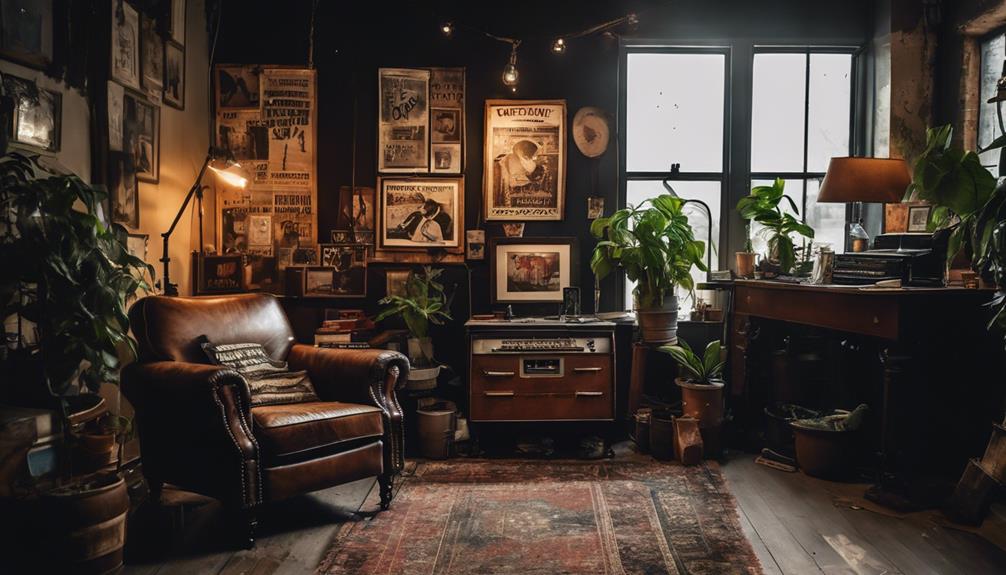
To elevate your grunge room, consider incorporating vintage band posters that capture the essence of your favorite music era.
Rustic wall-mounted shelves not only provide storage but also serve as a platform for showcasing unique finds like an antique typewriter.
These decorative elements create a perfect blend of nostalgia and individuality, enhancing the overall vibe of your space.
Vintage Band Posters
Vintage band posters serve as a defining element in grunge decor, capturing the rebellious spirit of iconic 90s rock bands like Nirvana and Pearl Jam. These posters often showcase vintage colors that evoke nostalgia, making them perfect for adding character to your room. To create an authentic vibe, source genuine vintage posters from thrift shops, flea markets, or online marketplaces.
When displaying your posters, opt for mismatched frames or even use washi tape for a more casual, lived-in look. This approach enhances the overall grunge aesthetic and gives your space a creative flair. Layering vintage band posters with other art forms—like graffiti or personal photography—can transform your wall into a dynamic gallery that reflects your unique taste.
Don't shy away from integrating posters with unique textures or finishes, such as matte or glossy surfaces. This adds depth and visual interest, making your decor even more engaging. By thoughtfully incorporating vintage band posters, you'll create an edgy atmosphere that resonates with the spirit of the grunge era and impresses all your friends.
Rustic Wall-Mounted Shelves
Enhancing your grunge decor with rustic wall-mounted shelves brings a raw, authentic touch that perfectly complements the overall aesthetic. These shelves, often made from reclaimed wood, add an earthy vibe that aligns beautifully with the grunge style. By displaying eclectic decor items like vintage vinyl records, quirky plants, or edgy artwork, you create a layered texture that's essential for achieving that disorganized charm.
Consider installing rustic wall-mounted shelves at varying heights to add visual interest, which reflects the unique and carefree spirit of grunge. Pairing these shelves with metal brackets or distressed finishes can amplify the industrial elements already present in your decor, further enhancing that edgy vibe you're after.
Moreover, these shelves serve as a canvas for personal expression. They allow you to showcase unique thrifted finds or DIY projects, making your space feel even more authentic. So, whether you're displaying your favorite band memorabilia or a collection of quirky trinkets, rustic wall-mounted shelves will elevate your grunge room, impressing all your friends with their stylish yet unrefined charm.
Antique Typewriter Display Piece
An antique typewriter acts as an enchanting focal point in your grunge room, infusing it with nostalgic charm and literary inspiration. This striking decorative element embodies vintage allure, making it a perfect centerpiece for a cozy reading nook or writing corner. By incorporating an antique typewriter into your decor, you evoke a sense of creativity that aligns beautifully with the grunge aesthetic.
To enhance its visual impact, consider displaying the typewriter on a distressed wooden table or a metal shelving unit, providing a stark contrast to modern decor elements. Surround it with eclectic items, such as vinyl records and vintage books, to capture the essence of grunge and create a cohesive look.
Pair the typewriter with personal mementos, like handwritten notes or vintage photographs, to curate a display that reflects your individuality and artistic flair. This not only enriches the atmosphere of your room but also invites conversation and admiration from friends.
Embrace the charm of an antique typewriter, and let it add character to your grunge sanctuary, making it a unique expression of your style.
Flooring
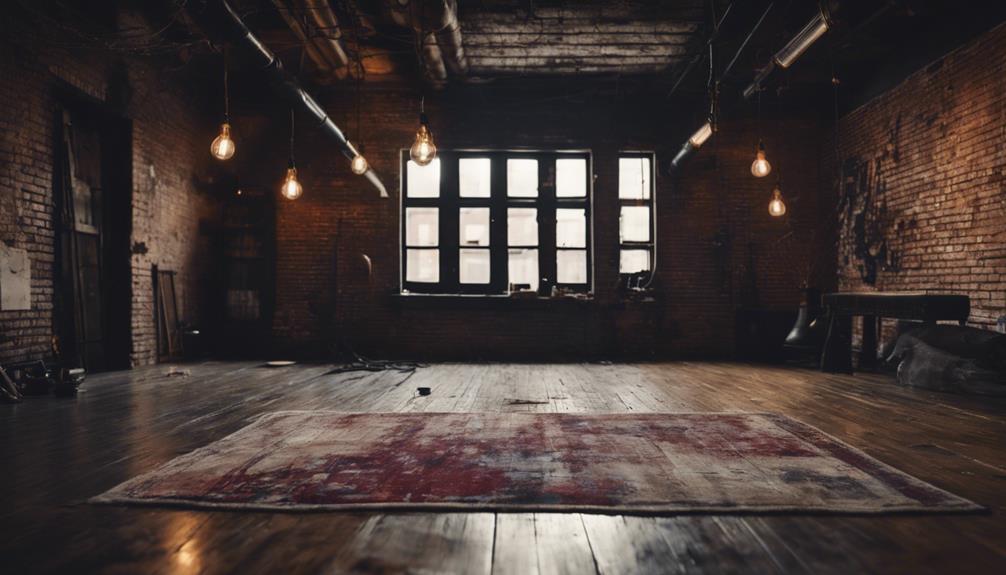
When choosing flooring for your grunge room, consider distressed dark hardwood planks to add warmth and character.
Weathered concrete finishes can bring in that edgy, urban vibe,
while faded black and white tiles offer a vintage touch.
Each option can set the perfect foundation for your grunge aesthetic.
Distressed Dark Hardwood Planks
Distressed dark hardwood planks bring an organic, raw aesthetic to your grunge room, perfectly aligning with the theme of authenticity and individuality. The deep hues of these planks enhance the moody atmosphere typical of grunge decor, creating a striking contrast against lighter elements in your space.
You'll appreciate the unique textures and imperfections, like knots and weathered marks, that contribute to the eclectic, lived-in feel essential for a grunge-inspired environment. These distressed dark hardwood planks aren't only visually appealing but also durable and easy to maintain, making them a practical choice for a room that encourages layering and rearranging.
You can easily incorporate area rugs over the hardwood to add warmth and additional texture, allowing for playful layering that embodies the grunge aesthetic. With distressed dark hardwood, you'll create a foundation that supports your creative expression, giving your room an edgy yet inviting vibe.
Weathered Concrete Floor Finish
Creating a weathered concrete floor finish instantly adds an industrial edge to your grunge room, enhancing its raw and authentic vibe. This flooring option not only looks great but is also durable and low-maintenance. You can achieve this weathered look through various techniques like staining, polishing, or applying a textured overlay, allowing you to personalize your space.
The muted gray tones of a weathered concrete floor finish blend seamlessly with darker walls and eclectic furnishings, reinforcing the grunge aesthetic. This versatility means you can effortlessly incorporate it into different decor styles, from edgy grunge to minimalist designs.
The cool surface of concrete provides a stark contrast that can be softened with layered rugs and textiles, adding warmth and depth to your room. This type of floor finish invites creativity and expression, making it an excellent choice for anyone wanting to make a statement.
Faded Black and White Tiles
Faded black and white tiles bring a striking contrast to your grunge room, amplifying its edgy and moody atmosphere. These tiles not only set the tone but also reflect a vintage or retro vibe, perfectly aligning with the eclectic and nostalgic elements that define grunge decor. When you select patterned or weathered faded black and white tiles, you add texture and depth to your flooring, enhancing the layered visual appeal of your space.
Incorporating tiles with a worn or distressed look evokes authenticity and character, embracing the imperfections that are central to the grunge ethos. This flooring choice allows you to create a unique environment where every imperfection tells a story.
Additionally, faded black and white tiles are incredibly versatile, easily complementing mismatched furniture and colorful accessories. They maintain a cohesive yet dynamic aesthetic that keeps your room feeling alive.
To fully embrace the grunge spirit, consider mixing these tiles with other raw materials and textures, allowing the faded black and white tiles to shine as a focal point. You'll impress your friends and create a space that feels both edgy and inviting.
How Can I Create an Edgy and Aesthetic Grunge Room Atmosphere That Will Impress My Friends?
Looking to impress your friends with an edgy grunge room atmosphere? Incorporate some edgy grunge room decor ideas like vintage band posters, distressed furniture, and dark color palettes. Mix in some industrial elements, like exposed brick or metal accents, to create a unique and aesthetic space they won’t forget.
Conclusion
By incorporating key elements like essential fixtures, edgy lighting, and unique decorative pieces, you can transform your space into a stunning grunge oasis.
Don't forget about the flooring; it sets the tone for your entire room.
With these ideas, you'll create an atmosphere that's not just aesthetic but also inviting for your friends.
So, get creative and let your personality shine through in every detail.
Your grunge-inspired room will be the ultimate hangout spot!




